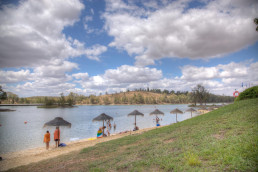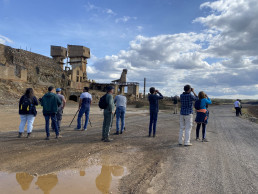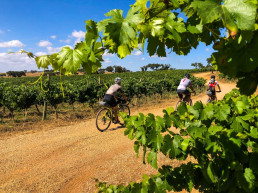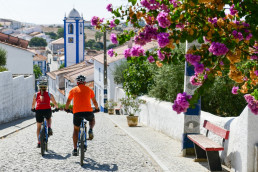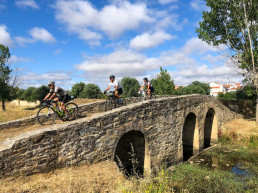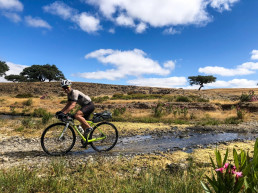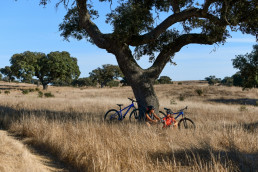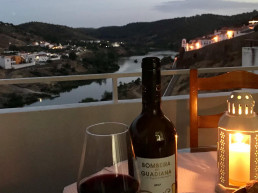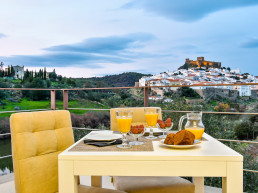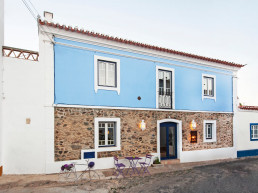GRAVEL GREAT CROSSING
Off the Road - Into the Wildscapes [Stage 5]
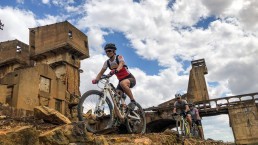
A loop along the left bank of the Guadiana River, cycling through the Natural Park and the mining heritage of the old São Domingos Mines. Here, the landscape becomes a scenario from a science fiction film: strange buildings collapsing and lagoons of (toxic) yellow, red or purple waters.
But Mina de São Domingos has more to offer, on hot sunny days, take a dip in Tapada Grande, a lake built to support the mine and which is now a blue flag fresh water beach.
In this area, the route overlaps with GR 15, a hiking and cycling trail that follows the Guadiana from Mértola to Vila Real de Santo António, the river mouth in the Algarve.
Distance
60,9 km
Duration
4:50 h
Ascendent
705 m
Descendent
705 km
Highest point
207 m
Lowest point
12 m
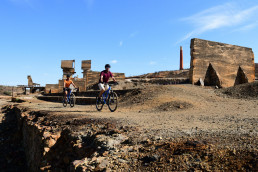
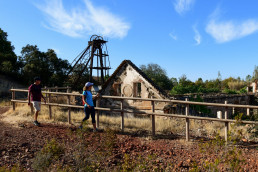
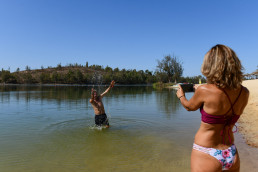
At Mértola cross the bridge to the East bank of the river Guadiana. After the harder initial climb, the asphalt and dirt roads will become more fluid and in perfect harmony with the landscape.
In the village of Pomarão, you can visit the pier and enjoy the company of the river. This was where the ore from the old mines would arrive by rail to be transferred and shipped by boat.
From here you can follow the road towards Minas de São Domingos and Santana de Cambas. As you continue along the path will soon become the old railway and the landscape will radically transform.
At the end of the day return to Mértola to enjoy a second night by the river.
O que visitar
Malacate – Mines of São Domingos
Hotspot
The capstan shaft number 6, built in iron and wood, was built to drain the water from the mine of the 150th floor, which permitted dry working conditions in the pit. Through a pumping system, the water was hauled in huge caudrons pulled by an electrical turbine, in a scale movement, after being channelled to a reservoir built next to the galleries of the mine. Today it's possible to walk around the site to better understand the way it worked.
Riverside beach of Tapada Grande
Hotspot
The riverside beach of the Sao Domingos Mine has existed since June 2000 and is located in Tapada Grande. It is the largest of two freshwater reservoirs created by the Mason & Barry Company during the 19th century to supply water for processing minerals of low content using the wet process. The location is equipped with a parking lot, toilet facilities, and a lifeguard during the swimming season. / [Guide of the Portuguese Geological and Mines Sites] www.roteirodeminas.pt
Pomarão river port
Hotspot
The Pomarão River Port was inaugurated in 1859 following the rediscovery of the mine in 1854 as was the port village and the railway. / Each year the port, located 40 km upstream from the mouth of Guadiana at the confluence with the Chança River, provided docking infrastructure for hundreds of ships bringing supplies and equipment for the mine and carrying away loads of ore. / The railway later arrived in Pomarão and connected the port to the mining extraction zone in Mina de Sao Domingos and the remaining locations of the industrial complex. / The first version of the railway system used animal traction (mules) and was inaugurated in 1862. The final version, with a wider gauge, steam-powered locomotives was inaugurated 5 years later, in 1867.
Achada do Gamo
Hotspot
Since the beginning of modern mining activities in the Sao Domingos Mine, Achada do Gamo was a centre for metalworking activities. During the 19th century working with raw minerals like copper pyrites required a special treatment process, in this case, sintering or roasting the materials in an oven. / During the 20th century, between the 1930s and 1940s, a new approach was taken in industrial exploration. The extraction of sulphur began from the already highly valued copper pyrite through the use of ovens in two manufacturing facilities installed in the Achada do Gamo. The impact of these activities on the environment is obvious to those who visit the place. It has transformed this into an otherworldly landscape. / [Guide of the Portuguese Geological and Mines Sites] www.roteirodeminas.pt
Portugal Wildscapes Experiences
Restaurant Casa Amarela
Restaurant
Traditional Alentejo cuisine with "sprinkles" of Chef. Casa Amarela Restaurant is the place in Mértola with the most breathtaking view! Located in Além Rio, it has a unique balcony with a panoramic view of the village and offers a diverse and authentic gastronomy. Closed for dinner on Sundays and all day on Mondays.
Casa de Pasto – Cafetaria Tamuje
Restaurant
A space for sharing and conviviality, from which you will never leave dissatisfied. Family restaurant and home cooking. A quiet place with regional authentic food, including black pig and river fish. It offers 3 exclusive balconies facing the river and closes on sundays.
Quinta do Vau
Accommodation
With a unique panoramic view of the Guadiana River and the historic centre of Mértola, Quinta do Vau turns your stay into an experience. Every morning or evening the view of the river and “old town” in the background are moments that linger in the memory of those who stay here.
Casa da Tia Amália1
Accommodation
As the name states, this was “Aunt Amalia's Home”. Casa da Tia Amália is a family house with a cosy atmosphere. Apart from double-rooms, it has some small-aparments with kitchnet, making it ideal for family-stays.
In Mértola, lays on margin with a priviledge view over the oldtwon. The house, which was almost in ruins, has been restored, and its spaces designed for comfort, scattered with details that show the care and dedication that the young owners put on restoring it. Quality and warm welcome are guaranteed.
